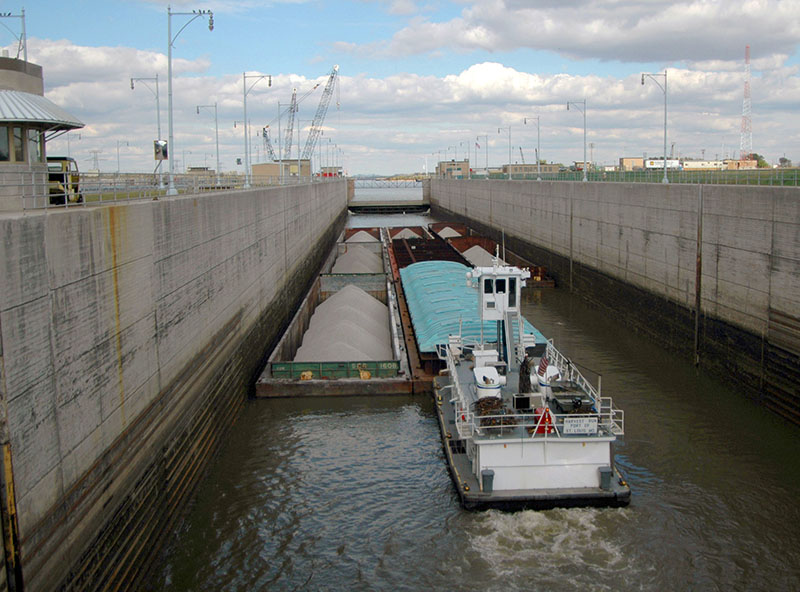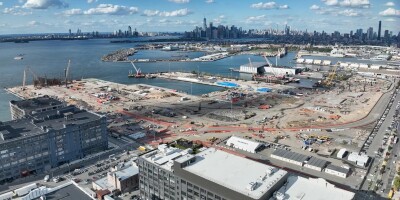President Trump signed into law two massive spending bills on Dec. 20 that include healthy budgets for ongoing inland waterways construction and maintenance as well as port dredging and investment, while also signing a defense bill that supports shipyard grants and would ease the transition from military to mariner jobs.
The legislative action on 12 spending bills, coming just days after the president’s impeachment vote in the House, avoided a government shutdown over the holidays that would have occurred if Congress failed to meet a Dec. 20 deadline when an existing stopgap measure to fund the government was set to expire.
Contained in the spending package for fiscal 2020 was $7.65 billion for the civil works mission of the U.S. Army Corps of Engineers, which oversees the inland waterways system and port dredging. That amount is $652 million above the current spending level and $2.69 billion more than the president had requested earlier this year, according to the Waterways Council, an industry-funded group that advocates for waterways spending.
WCI said that a significant part of this Energy and Water Development Appropriations Act is an adjustment by Congress to the construction cost-share for the Chickamauga Lock and Dam near Chattanooga, Tenn., pushing the federal share of the project to 65% and decreasing the funds taken from the Inland Waterways Trust Fund (IWTF), which is supported by a diesel tax paid by the barge industry, to 35%. Normally such projects are funded 50-50. WCI has said that this formula change will speed Chickamauga’s progress and free up money in the IWTF for other inland projects that have been stalled in the funding pipeline.
The bill also includes another provision sought by the waterways industry: full use of the estimated receipts of the IWTF that includes additional prior-year revenues to produce a strong investment level of $317 million for spending on needs of the antiquated inland waterways system during the next fiscal year.
The Corps’ Operations and Maintenance account also received a boost: the $2.68 billion funding level is $1.37 billion more than the president’s request and $498 million more than this year’s spending level, WCI said.
In other good news, projects funded through the Harbor Maintenance Trust Fund will receive $1.63 billion, up by $665 million above the president’s request.
WCI President Mike Toohey praised the strong funding for waterways, saying it was the result of “bipartisan leadership” from both Republican and Democratic leaders in the House and Senate who realize the importance of waterways commerce to the U.S. and global economies.
The American Association of Port Authorities also praised the funding bills, saying that the $225 million allocated for port infrastructure will be spent on improvements to gate operations, roads and rail within and connecting ports, ship berths and cargo operations.
“Ultimately much more is needed, but this package reflects the association’s ongoing priorities for improving the critical infrastructure that is represented at America's seaports and will go a long way to enhancing trade and transportation across the nation,” said AAPA President Chris Connor in a statement.
AAPA also noted that the Corps of Engineers received a 12% increase in spending for deep-draft dredging projects and got money for a regional demonstration program to respond more effectively to critical national dredging requirements along the Gulf coast between Louisiana and Alabama. In addition, $104 million from the Customs and Border Protection budget will help hire more than 600 more officers and agriculture specialists to help ease border trade, while $100 million will fund the port security grant program.
The 2020 National Defense Authorization Act, which Trump also signed on Dec. 20, also includes important maritime provisions, including authorizing funding for the Port and Intermodal Improvement and Small Shipyard Grant programs. It also requires a report on the infrastructure needs of strategic U.S. ports, reauthorizes the Maritime Security Program and codifies Marad’s Military to Mariner program that helps veterans from sea services obtain civilian mariner licenses.





